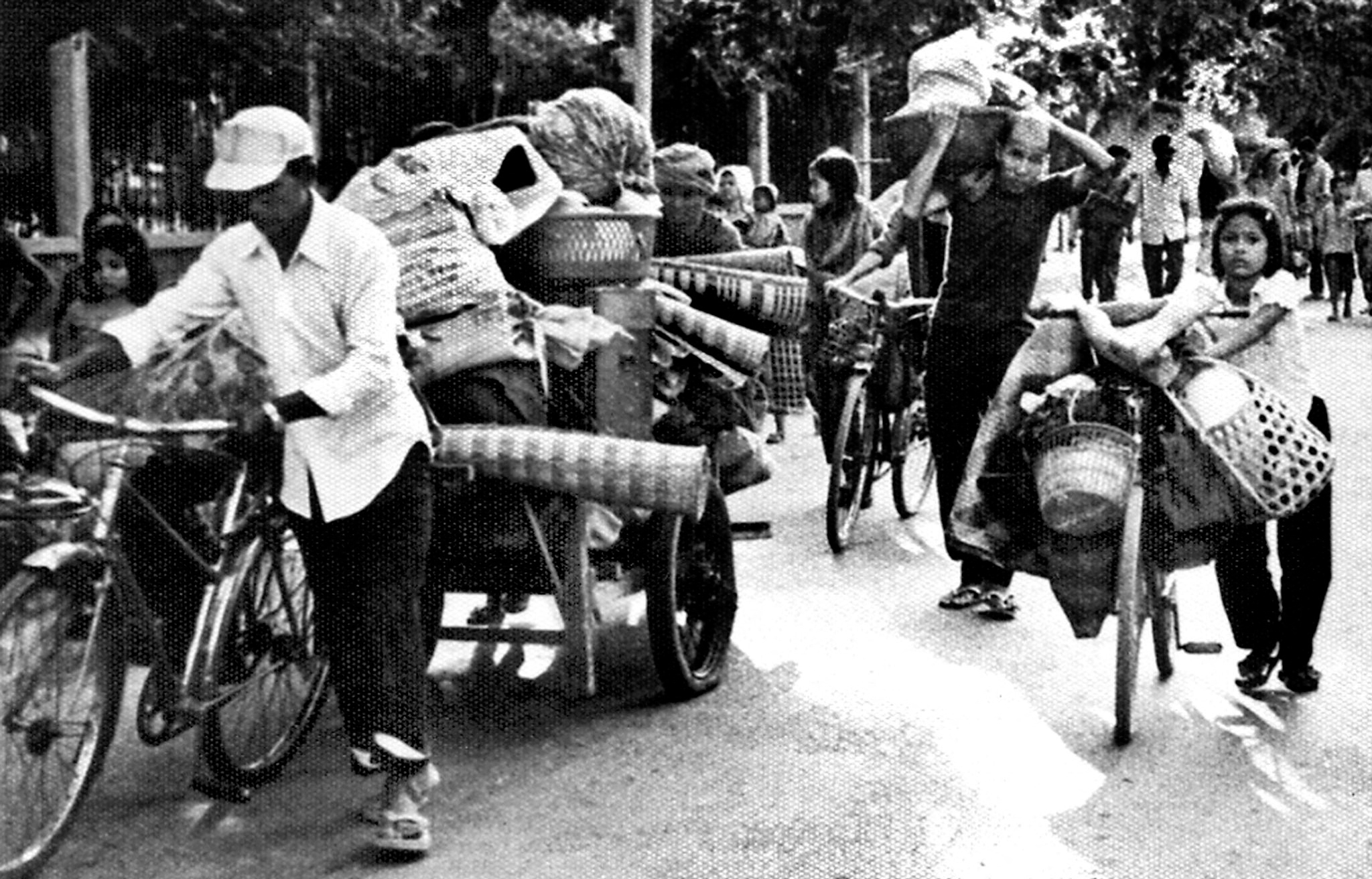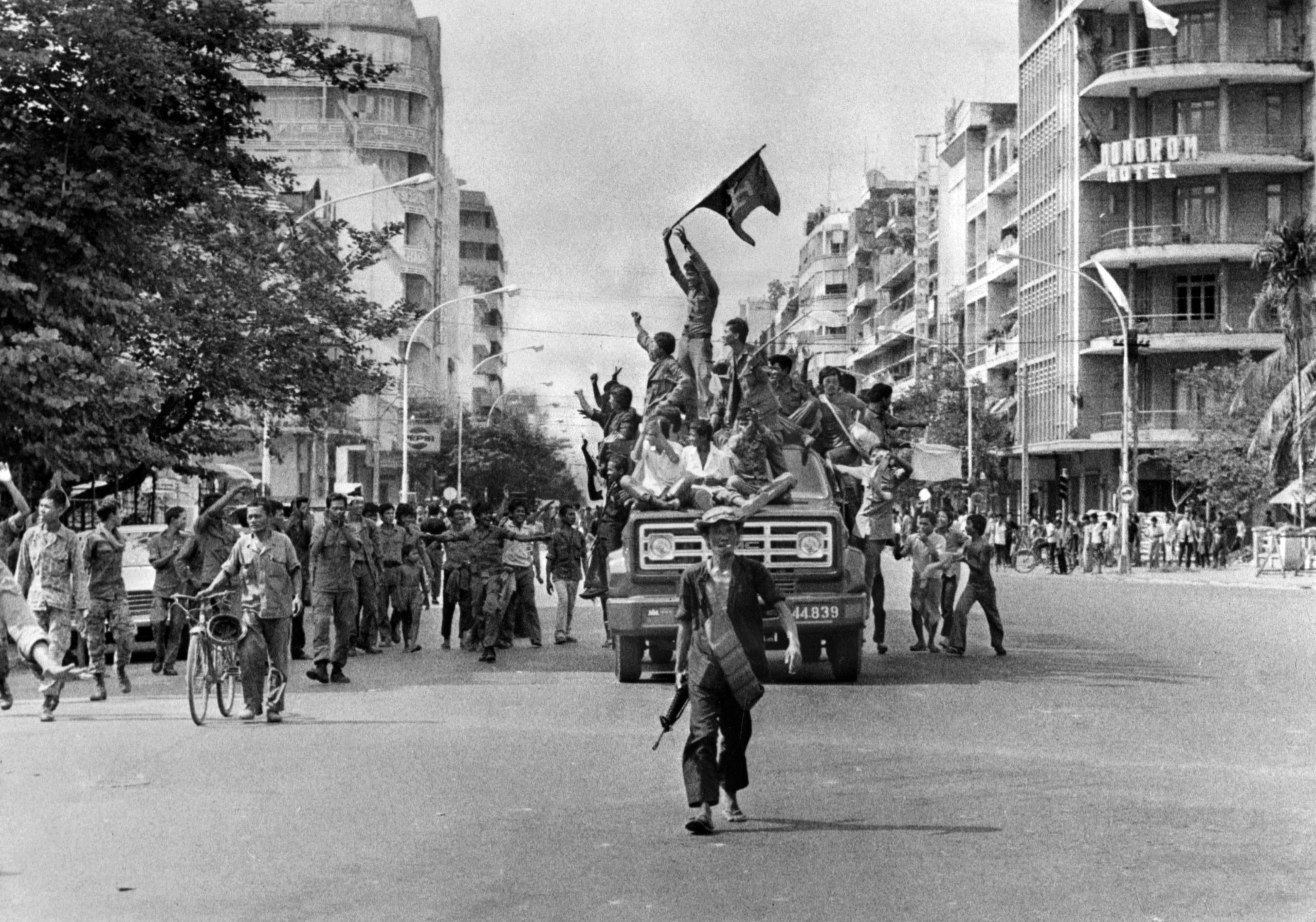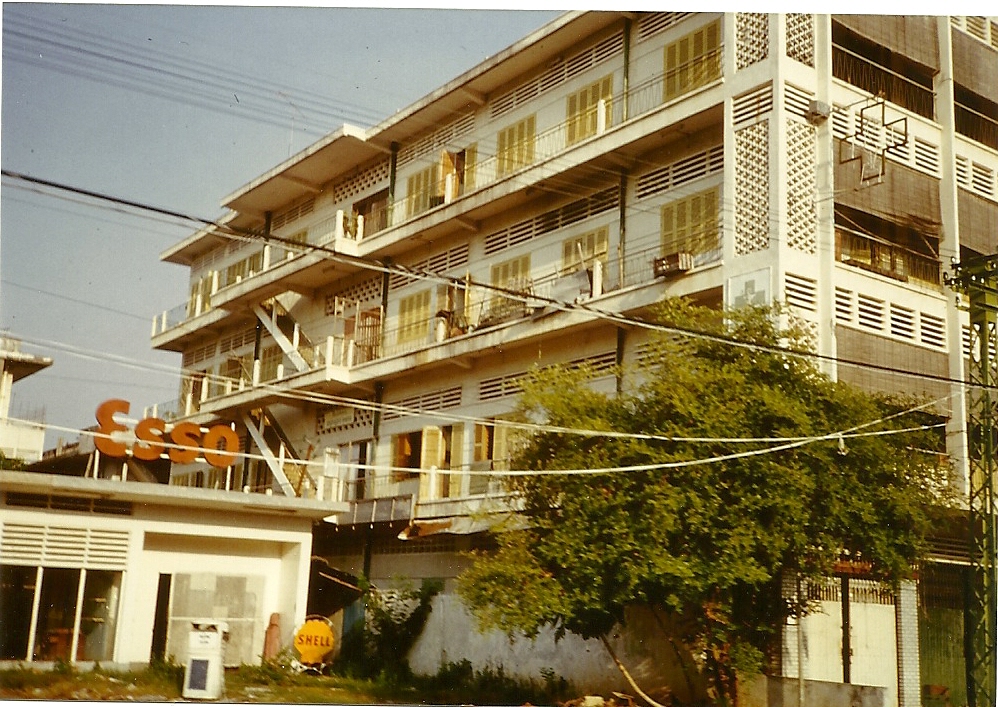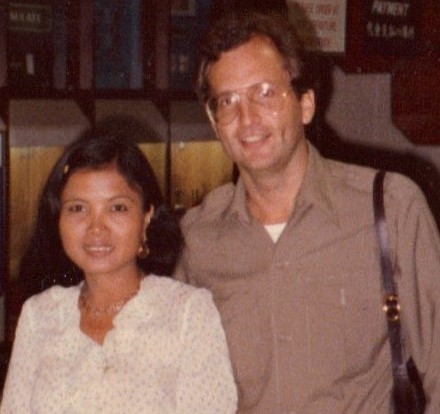The following is adapted from Chapter 11: Angkar of The Last Helicopter: Two lives in Indochina, a book by US journalist Jim Laurie. April 12 was the 46th anniversary of the day Laurie fled Phnom Penh in the US helicopter evacuation as the Khmer Rouge entered the city. He left behind Soc Sinan, a woman he had fallen in love with, who would ultimately survive the Cambodian genocide. Below is Sinan’s account of the immediate aftermath of the fall of Phnom Penh to communist forces on April 17, 1975.
A bold headline spread across the front page of the New York Times read, Phnom Penh surrenders to rebel forces after offer of ceasefire is rejected.
“Rebel forces”: Exactly who were they? Conditions in the Cambodian capital were such that in April 1975 very few – including Soc Sinan, myself and most city residents – knew much.
We knew much about the Vietnamese communists and how they would behave. Their leaders were accessible in Hanoi. Many of us had met with Vietnamese communist officials in Paris or even in Saigon after the 1973 Paris peace treaty.
For the most part, contact with Khmer communists did not exist. Most people knew only their figurehead – Norodom Sihanouk.
The only other person some in Cambodia had heard of was the “socialist” professor at the University of Phnom Penh in 1959, Khieu Samphan. Khieu went into hiding after Sihanouk ordered his arrest in the 1960s. When he emerged from hiding after 1970, it was into top positions within the Khmer Rouge.
The other leading radical communists, including Pol Pot, whose name later became synonymous with genocide, were unknown to us in the early ‘70s.
The only name Sinan soon came to know was the name “Angkar”. It was on the lips of every “revolutionary” soldier she met.
Simply translated, “Angkar” or “Angka” meant “the organization.” It comprised the governing body of the Communist Party of Kampuchea. Sinan wrote later:
“It was clear looking at these young soldiers that they did not trust us at all.
They walked back and forth, stared and shouted.
At 3 p.m. on April 17th exactly, I saw a long procession of people, walking north to south. They carried their belongings on their backs and on their heads. Some had mopeds, some slowly moved push carts. Some had children in small trolleys. They pushed them slowly along.
I looked around. Suddenly even my neighbors were leaving their homes. Many had already packed their essential belongings. Everyone was leaving!
I descended the stairs of my apartment building to the sidewalk. I saw a Khmer Rouge with a loud hailer.
“You must get out of the city. You will be gone for three days. Do not take many things. Take rice for yourself, some cooking pots, and mats to sleep at night. That’s all! Angkar commands it!”
They repeated their warnings. “Everyone must leave. American airplanes are coming soon to bomb. Leave quickly before it is too late.” I listened. But I was confused.
A book I had read about China’s Cultural Revolution came to my mind. I also remembered warnings: The Khmer Rouge were extreme in every way. They could not be trusted.
I decided I did not believe Angkar. I was not going anywhere! I returned to my apartment, closed my window and shutters, and lay down on my bed. I thought back on all the wonderful times I had had in the city.
My job at the French firm. Jim and the other Americans I met. I had very few worries when I met Jim in 1970. Now I must adjust to a new reality.
Lying down, I just stared at the ceiling. Around 4 p.m., I decided to venture out once more. I saw my neighbor Mme Reine preparing to leave with her husband and children. Everyone looked upset.
I held Mme Reine’s hands. She looked deep into my eyes with affection. She said, “I may never see you again, but whatever happens may the spirit of Buddha and the angels of the eight corners always be with you.”
As night fell – it seemed only three of the twelve apartments on my floor were still occupied. Myself and two others. Each retreated into our private worlds.
I ate a little food. I turned on a big fan. I lay down again. I kept the shutters closed, lights off. I did not want the KR to see me. I tried to sleep.”

In Bangkok, I continued to monitor Cambodia as best I could. The last international news transmissions from Phnom Penh went out a little after 1 in the afternoon from the old post office (PTT) where I used to file my stories.
The PTT did not open again for more than four years. My residence, the Hotel de la Poste and La Taverne, where Sinan and I had often dined, across the street never reopened.
On Friday, April 18, hiding in her apartment, Sinan finally began to pack her belongings.
“As the sun came up, I looked out the window.
People still streamed down Monivong leaving town. I saw people on hospital trolleys with tubes of serum still clinging to their bedsides being pushed along.
No one seemed to pay attention to anyone else. Everyone appeared consumed with their own crisis.
I saw a line of Buddhist monks. They were being forced to march out of the city from the temples. What was happening? We were Buddhists. We did not mistreat monks!
I shook myself back to reality. I continued to pack. I sorted through my mail. I had a full drawer of letters, letters from Jim, letters from Walter, the Army commander I met at the American Military Equipment Delivery Team party.
I selected a few important letters. I must throw the rest away. My life depended on it. If the Khmer Rouge found these letters from foreigners, I’d be doomed.
I put them all in a large brown bag. I looked outside and quickly raced down the stairs to street level. I ran around the back of the Esso gas station. I remembered there was a wide drain for refuse at the back. I quickly got rid of the bag.I looked around to see if anyone noticed. No one had.
I raced back upstairs. It was 5:00.
I looked out the window. On the second day after the victory of Angkar, the city had died. After dark, it was a city only of sounds. Electricity still operated but there were few lights.
At about 9:00, I could hear soldiers moving about in the big houses next to my apartment building. I could hear the soldiers, breaking things. Destroying, tearing things up. I heard a window shatter. Then I heard laughter. They burst into song – revolutionary songs. Occasionally I heard shots fired. I think into the air.
I tried to eat. I tried to sleep. Most of all I just tried to keep quiet. Prisoner in my own apartment.


On Sunday, April 20, as she wrote later, Sinan’s situation suddenly changed. She had defied Angkar’s orders. Soldiers began conducting a house-to-house search. They broke locks and doors, wantonly destroyed property, and stole what they thought might be useful. They arrived at Sinan’s apartment building waving their AK-47 rifles around.
As the Khmer Rouge shot the bolt on the door and entered her apartment, Sinan cowered by her bedside and feared she would soon be dead. Two soldiers aimed their rifles at her head.
“I was in that world just in between life and death. I prayed to be spared.
They shouted – “Put your hands down. Don’t pray to us. There is no prayer in revolution. Why are you still here? Everyone else has left, evacuated to the countryside.”
I tried to answer their questions and lied.
‘I was ill. I just got out of hospital a few days ago.’
They listened but kept their rifles on me.
You must be a rich capitalist. Otherwise, your husband could not go abroad. The poor cannot afford to go anywhere. They only work. The capitalists just get rich
They asked me where my husband was. I said he left me and went abroad. They grilled me on my illness. I then thought of something. I had had an operation a few years back. There was a scar on my abdomen.
So I said I had had serious surgery and showed them the scar. They clearly did not know a new scar from an old one. They seemed to have a moment of pity and then launched into an attack on my “husband.”
“You must be a rich capitalist. Otherwise, your husband could not go abroad. The poor cannot afford to go anywhere. They only work. The capitalists just get rich.”
I made no reply. They finally put their rifles down.
I looked at the soldiers. I made an observation that was to help me later. The soldiers did not wear the same uniforms. While both wore what we called Vietnamese sandals, they were different in other ways.
One was younger and wore long black cotton trousers with a rubber belt. He had a black long-sleeve shirt and wore a Mao Zedong–style hat. The older soldier wore military green, not that different from that worn by the old Lon Nol army. He had a dark-green Chinese hat.
The young soldier dressed in black was about 18 years old. He spoke with an accent common to the southwest of Cambodia. He had little education. The older soldier dressed in green was perhaps 25. He seemed to have some education, but I could not place his accent.
I later learned that the black uniformed Khmer Rouge were from the southwest region. Originally from Kandal, Takeo or Kampot, these young soldiers were known for their cruelty and were considered the most pure in communist ideology.
Those dressed in military green were from the eastern region – east of the Mekong River. They were considered better educated, more tolerant.
The one in the black uniform did most of the talking, most of the threatening. It was clear he was the one who could shoot me.
When I thanked him for not shooting me, he said, “Don’t thank us, thank Angkar. But you and your kind must pay for being slaves of imperialists.”

The young man in black suddenly turned and left my apartment to batter down the next door. Then I asked the soldier in green, who seemed slightly kinder, about the instructions of Angkar.
“I was told that the people would have to leave the city for only three days,” I said. “But now it is day four and no one has returned?”
He did not admit those instructions were lies. He simply said, “Angkar wants to make people feel more comfortable in leaving their homes. In fact all people will have to resettle in the countryside and grow rice. People in the city had life too easy for too long. People in the country had to hide in bunkers, leading miserable lives under the constant bombardment of the Americans and their B-52s.”
“We have expelled the US imperialists,” he said. “Now it is your turn to work for the revolution. Go, take everything you can. Don’t leave things here. You will never come back to this apartment again! You will become a farmer for the rest of your life.”
The soldier in green then disappeared through my broken door. I had delayed as long as I could. I repacked once more. I looked at the five suitcases I had packed. I wondered how I could carry them. I walked to the ground floor to look for a cart or a trolley. I found a cart at the abandoned pharmacy next door. I pushed my cart back to the bottom of the apartment building stairs. One by one I brought my suitcases down from the fourth floor. I went back to my apartment for the last time.
I would begin a long walk, a very long walk, alone, eastward through an abandoned city. Before I left, I found in a drawer three incense sticks. I arranged my mother’s picture on the small table by my bed. I lit the joss sticks. The trace of smoke glided upward.
I prayed to Buddha. I looked at my mother and prayed for her blessing, prayed for her help.”
A second excerpt from Laurie’s book – Chapter 18: Giải Phóng (Liberated), documenting Laurie and photojournalist colleague Neil Davis in Saigon after the US Embassy led evacuation of April 29-30, 1975 – can be read here.


